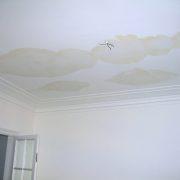Preventing Mold After Water Damage
If you’ve had any water damage to your home after a storm or flooding, you have roughly a 72-hour window to prevent the growth of mold. Mold that can be extremely hazardous to you and your family’s health. It’s highly important that you start the process of drying out your water damage or you could be left with repairs to your home that are even more time consuming then they already will be. Not to mention that mold can cause health issues like fever and difficulty breathing. Those with existing lung issues like Asthma are especially susceptible to these issues and should not be anywhere near mold.
If mold begins to grow, the process of getting your home and life back to normal must wait until all the mold is removed and your restoration company is given the OK to get started on the repairs.
Keep in mind that the process of drying out the water damage is not always straightforward and often what appears dry is not. Most moisture is often hidden in the walls and flooring, so it’s critical to identify and dry all the affected areas to prevent the growth of mold!
Can You Dry the Water Damage Yourself?
While you might think that you can dry out your water damaged areas yourself by using fans and wet-vans, we’ve found that most homeowners never fully dry out the water damaged areas. This is simply because they don’t have the proper tools to detect hidden pockets of mold-growing wet areas. Your best bet is to hire a professional to dry out your water damaged areas.
The cost to professionally dry your water damaged areas is almost always covered by insurance so it doesn’t cost you anything more to have a restoration company dry out your water damaged areas to speed up the time to getting life back to normal.
Can You Kill The Mold Yourself?
While some property owners will try to dry the area or spray bleach, the truth is that these methods often only spread the mold to other areas of the home. What’s worse, AC and heating systems can spread the spores throughout the home through the air.
So please do not try to kill the mold yourself. You can Google “How to kill mold” and find hundreds of ways to do that, but those methods are usually for surface area mold, NOT for water damaged area mold.
What to Do Until Help Arrives?
One big step that you can take to prevent mold from growing until help arrives is simply assessing and mitigating the damage as quickly as possible. Mitigating the loss is an insurance term in most policies that means you are responsible to do everything in your power to contain the damage.
When you are dealing with water damage and a potential mold problem, there are a few definitive do’s and don’ts to implement while you’re waiting for help to arrive.
- Shut the water off.
- Be sure to turn off all Air Conditioning units and heating systems. Excess coolness or heat can complicate the drying process.
- Next, turn off all fans that you have running. These aren’t helping you dry the area like you think they are. In fact, they will often spread mold throughout the home quicker.
- Pick up any personal items from the floor that would add to your loss.
- Try to either move furniture out of the wet area or lift it up and put something under the legs such as a block of wood that will keep it out of the water.
Don’t throw anything away! If possible, take photos to document all your damage. This will be helpful if, and when, you file an insurance claim.






